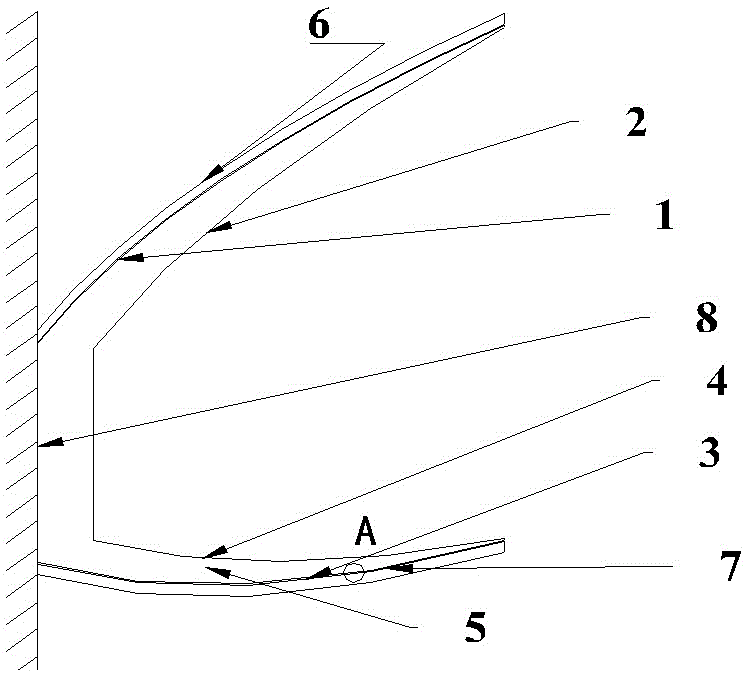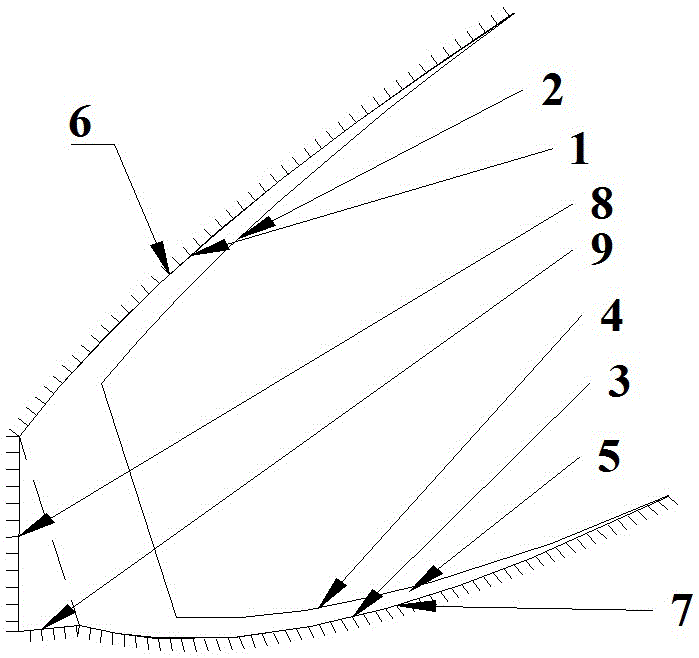Solar interior wall lens type composite parabolic concentrator applied to building south wall
A compound paraboloid and concentrator technology, applied in the field of solar energy utilization, can solve problems such as the limitation of light receiving angle, and achieve the effects of increasing the light receiving angle, improving uniformity, and improving the distribution of light intensity
- Summary
- Abstract
- Description
- Claims
- Application Information
AI Technical Summary
Problems solved by technology
Method used
Image
Examples
Embodiment 1
[0029] see figure 1 , the solar inner wall lens type compound parabolic concentrator used for the south wall of the building is an asymmetric U-shaped compound parabolic concentrator as a whole. It includes a lens 5 with an asymmetric U-shaped cross section, an upper compound parabolic reflector 6 , a lower compound parabolic reflector 7 and a frame, and the lens 5 is correspondingly installed between the upper compound parabolic reflector 6 and the lower compound parabolic reflector 7 . The light receiving angle of the concentrator is 20-80°.
[0030] The upper compound parabolic reflector 6 is designed with a maximum light receiving half angle of 42°, and the lower parabolic reflector 7 is designed with a maximum light receiving half angle of 0°.
[0031] see image 3 , the outer curved surface and the inner curved surface of one side wall of the lens 5 are the upper outer compound paraboloid 1 and the upper inner curved surface 2 respectively, and the outer curved surface...
Embodiment 2
[0035] see figure 2 , in order to popularize and apply the concentrator of the present invention to low and middle latitude regions, the bottom surface of the concentrator is rotated counterclockwise around its upper top edge at an angle of 6° to form an included angle with the installation wall; Connected upright mirror surface 8 and connecting mirror surface 9, upright mirror surface 8 is connected with the inner edge of upper compound parabolic reflector 6 at the same time, connecting mirror surface 9 is connected with the inner end edge of lower compound paraboloid reflector 7 at the same time. The function of the connecting mirror 9 is to reflect light onto the upright mirror 8 .
[0036]Studies have shown that in this way, the range of the receiving angle of the concentrator can be effectively changed, so that it can also guarantee the annual receiving radiation time of 8 hours per day in low latitude areas. For example, in Beijing at 39°54’N116°23’E, the incident angl...
Embodiment 3
[0039] see figure 2 , the upright mirror 8 is disconnected from the main body of the light collector, and the geometric light collector of the light collector can be increased by reducing the length of the upright mirror 8 . The length of the upright mirror 8 is reduced to 5.6 mm, and the geometric light concentration ratio is increased to 2.75 without affecting the optical performance and acceptance angle of the light collector.
[0040] Other structures are with embodiment 1.
PUM
| Property | Measurement | Unit |
|---|---|---|
| Thickness | aaaaa | aaaaa |
Abstract
Description
Claims
Application Information
 Login to View More
Login to View More - R&D
- Intellectual Property
- Life Sciences
- Materials
- Tech Scout
- Unparalleled Data Quality
- Higher Quality Content
- 60% Fewer Hallucinations
Browse by: Latest US Patents, China's latest patents, Technical Efficacy Thesaurus, Application Domain, Technology Topic, Popular Technical Reports.
© 2025 PatSnap. All rights reserved.Legal|Privacy policy|Modern Slavery Act Transparency Statement|Sitemap|About US| Contact US: help@patsnap.com



